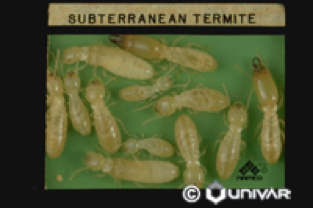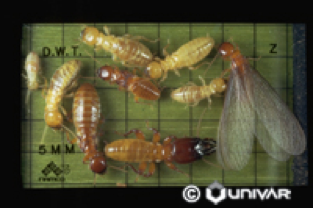Termites
Termites Have Inhabited Earth for Millions of Years and Were the First Social Insects to Use a Caste System
Throughout history, humans have built wooden structures and made them accessible to termites by having them in contact with the soil. Romans referred to them as “Termes” which means “wood worm” Their fossilized remains have been found in formations some 55 million years old and to this day their diet still consists solely of wood and other cellulose materials. Termites are so destructive for a number of reasons. The individuals are long lived, the colony is self- perpetuating and they have a constant supply of food. A normal colony can consist of 50to 60 thousand members and a large colony can number in the millions. One this size can ingest nearly 1.1 lbs. of wood a day! Much like ants, termites develop using a caste system, where circumstances determine whether they need workers, soldiers, or reproductive members depending on the needs of the colony. Termites live in highly structured and integrated societies, that still pose many questions as to how and why they operate the way they do. One thing is certain, they are firmly rooted worldwide and are not going anywhere.
 Subterranean Termite
Subterranean Termite
This termite is the widest spread and destructive termite group in the United States. They excavate passageways through the soil to reach wood buried in or in direct contact with the ground. Materials above the ground are reached either by moving through connecting wood or through soil tubes which they construct over concrete, masonry and other impervious materials. The worker termites construct “shelter tubes” from tiny particles of soil, wood or debris cemented together with secretions and fecal material. Soil tubes serve as protection for the termites from natural enemies and the drying effects of air movement. Termite workers are very partial to sunlight, heat and air movement and therefore must be in contact with the dampness of the soil to ensure they do not dry out.
Workers appear to look like off white maggots with legs, a darker section at the head and chewing mouthparts. The soldiers are larger and darker in color with huge mandibles and upon the destruction of an occupied soil tube, will come to the aid of the workers in defending the colony. Although it is customary for Subterranean Termites to periodically return to the soil for moisture, if conditions are suitable, isolated groups of termites can survive and multiply above ground without soil contact. Especially where they have access to moisture sources such as condensation, plumbing or structural leaks. With adequate food, moisture, and a supply of replacement reproductive, such infestations are capable of functioning independently of the original colony and surviving indefinitely. When a colony becomes over populated, reproductive grow wings and become “swarmers”. In the warmer months, they leave the nests in droves in search of new areas to inhabit. Once they have found a new location, they drop their wings and begin colonizing the new area with the reproductives becoming a satellite colony.
 Drywood Termites
Drywood Termites
This termite lives entirely in dry, sound wood. Unlike Subterranean Termites, they require no connection with the soil and no above ground moisture source. All the moisture they need is obtained from the wood they consume. Drywoods attack the structural timbers and wood work of buildings as well as furniture, hardwood flooring and wooden articles of all kinds. New colonies are initiated when the swarmers enter cracks, knotholes or joints and bore into the wood. They often enter houses through an unscreened attic or foundation vents or cracks in the building’s exterior. Drywood termite colonies are small in comparison to Subterranean colonies containing perhaps a few thousand individuals. Multiple colonies may be present with up to several dozen per structure. The likelihood of multiple colonies may be present with up to several dozen per structure. The likelihood of multiple infestations increases with the building’s age. The damage inflicted is different than that of the Subterranean. No soil tubes are produced and there is no evidence of soil in feeding galleries. They construct large galleries with the wood grain and consume both the soft and harder sections. The cavities are clean and smooth as though they were worked with sandpaper. The most obvious sign of infestation is the tiny fecal pellets which they eject from the galleries. Unlike soil treatments to control Subterranean termites, Drywood termite infestation must be fumigated to ensure all the termites in the home are terminated.
 Dampwood Termites
Dampwood Termites
The Western Drywood termite is the most destructive Drywood termite in the Western United States. They are generally recognized by their dark body, smoky gray wings and reddish head and thorax. In Northern California, swarming typically occurs in June and July during the daylight hours. This termite only infests wood with a high moisture content. The colonies are entirely wood dwelling and do not require contact with the soil. Commonly found in fallen logs, tree stumps and damp or decaying wood. Infestations in structures can occur when wood is in contact with the ground or in areas wetted by moisture leaks. Dampwood termites are noticeably larger than Subterranean. They vary in size based on castes from ½ to ¾ inches in length for soldiers and nymphs to swarmers coming in at 1 inch including the wings. If the wood is sound the Dampwood termite will feed on the softer “spring” wood like the Subterranean. If the wood is decaying the tunnels will extend across the grain, similar to that of the Drywood.
Have you spotted an unwanted critter in your home or business? If so, there's probably more where that came from! Contact Parish Termite & Pest Management today to schedule your free inspection and estimate!
